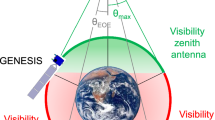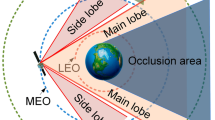Abstract
The importance of having high levels of reliability in Global Navigation Satellite Systems (GNSS) signals has increased gradually in recent years. Among other factors, evaluating the available power and its spatial characteristics at the user location is a key task as part of signal quality verification processes. Due to a diversity of factors, the transmitting antennas of GNSS satellites may exhibit a non-nominal on-orbit performance. As a result, the effective isotropically radiated power of navigation signals may be affected, e.g., due to azimuthal asymmetries in the antenna gain pattern. If not analyzed and handled properly, such irregularities may lead to the use of weak signals from a given satellite, possibly resulting in non-admissible positioning errors. The present contribution aims at the analysis of the on-orbit performance of GNSS satellite antennas, using data from the Galileo system as a case study. Employing reconstructed gain patterns, a set of metrics is defined, which intend being used as performance evaluation values. In addition, the concept of antenna performance stability is explored by analyzing changes over time of reconstructed gain patterns. Results using data from the operational Galileo satellites (up to the beginning of 2019) have been obtained. From the computed example reconstructed patterns, gain variations below 0.5 dB and azimuthal asymmetries at the 0.6 dB level (95%) were found for most of the analyzed satellites. Likewise, the obtained results suggest the occurrence of an event that altered the nominal performance of the antenna of Galileo satellite 0102 during the first years of operation. The presented tools and results may be of particular interest for applications requiring navigation signal power monitoring tasks, such as GNSS reflectometry or safety–critical systems.








Similar content being viewed by others
Data availability
Data supporting this research have been obtained from the publicly available global data centers of the International GNSS Service. They can be found at http://mgex.igs.org/IGS_MGEX_Data.php.
References
Allende-Alba G, Thoelert S (2020) Reconstructing antenna gain patterns of Galileo satellites for signal power monitoring. GPS Solut 24:22. https://doi.org/10.1007/s10291-019-0937-9
Banville S, Tang H (2010) Antenna rotation and its effects on kinematic precise point positioning. In: Proceedings of ION GNSS 2010, Institute of Navigation, Portland, Oregon, USA, September 21–24, 2545–2552
Betz, JW (2016) Engineering satellite-based navigation and timing. Global navigation satellite systems, signals and receivers. Wiley-IEEE Press, USA
Circiu MS, Meurer M, Felux M, Gerbeth D, Thoelert S, Vergara M et al (2017) Evaluation of GPS L5 and Galileo E1 and E5a performance for future multifrequency and multiconstellation GBAS. Navigation 64(1):149–163. https://doi.org/10.1002/navi.181
De Bakker PF, Tiberius CCJM (2017) Real-time multi-GNSS single-frequency precise point positioning. GPS Solut 21(4):1791–1803. https://doi.org/10.1007/s10291-017-0653-2
Donaldson JE, Perker JJK, Moreau MC, Highsmith DE, Martzen P (2018) Characterization of on-orbit GPS transmit antenna patterns for space users. In: Proceedings of ION GNSS + 2018, Institute of Navigation, Miami, Florida, USA, Sept 24–28, 1208–1245
Dow JM, Neilan RE, Rizos C (2009) The international GNSS services in a changing landscape of global navigation satellite systems. J Geodesy 83:191–198. https://doi.org/10.1007/s00190-008-0300-3
Falleti E, Pini M, Lo Presti L (2011) Low complexity carrier-to-noise ratio estimators for GNSS digital receivers. IEEE Trans Aerosp Electron Syst 47(1):420–437. https://doi.org/10.1109/TAES.2011.5705684
Katsigianni G, Perosanz F, Loyer S, Gupta M (2019) Galileo millimeter-level kinematic precise point positioning with ambiguity resolution. Earth Planets Sci. https://doi.org/10.1186/s40623-019-1055-1
Li C (2017). A simple and efficient on-board calibration method of satellite phased array antenna. In: Proceedings of the 2017 international applied computational electromagnetics society symposium, Suzhou, China, August 1–4
Maral G, Bousquet M (2009) Satellite communication systems: systems, techniques and technology. Wiley, UK
Marquis, WA (2016). The GPS IIR antenna panel pattern and its use on-orbit. Proc. ION GNSS + 2016, Institute of Navigation, Portland, Oregon, USA, September 12-16, 2896-2909
Marquis WA, Reigh DL (2015) The GPS block IIR and IIR-M broadcast L-band antenna panel: its pattern and performance. Navigation 62(4):329–347. https://doi.org/10.1002/navi.123
Montenbruck O et al (2014) The multi-GNSS experiment (MGEX) of the international gnss service (IGS): achievements, prospects and challenges. Adv Space Res 59(7):1671–1697. https://doi.org/10.1016/j.asr.2017.01.011
Montenbruck O, Schmid R, Mercier F, Steigenberger P (2015) GNSS satellite geometry and attitude models. Adv Space Res 56(6):1015–1029. https://doi.org/10.1016/j.asr.2015.06.019
Ruf C, Lyons AH, Unwin M, Dickinson JR, Rose RG, Rose D, Vincent M (2013) CYGNSS: enabling the future of hurricane prediction. IEEE Geosci Remote Sens Mag 1(2):52–67. https://doi.org/10.1109/MGRS.2013.2260911
Steigenberger P, Thoelert S, Montenbruck O (2018) GNSS satellite transmit power and impact on orbit determination. J Geodesy 92(6):609–624. https://doi.org/10.1007/s00190-017-1082-2
Steigenberger P, Thoelert S, Montenbruck O (2019) Flex power on GPS Block IIR-M and IIF. GPS Solut 23:8. https://doi.org/10.1007/s10291-018-0797-8
Thoelert S, Meurer M, Erker S (2012) In-orbit analysis of antenna pattern anomalies of GNSS satellites. Navigation 59(2):135–144. https://doi.org/10.1002/navi.11
Thoelert S, Enneking C, Vergara M, Sgammini M, Antreich F, Meurer M, Brocard D, Rodriguez C (2015). GNSS nominal signal distortions—estimation, validation and impact on receiver performance. In: Proceedings of ION GNSS + 2015, Institute of Navigation, Tampa, Florida, USA, September 14–18, 1902–1923
Wang T, Ruf C, Block B, McKague D, Gleason S (2018) Characterization of GPS L1 EIRP: transmit power and antenna gain pattern. In: Proceedings of ION GNSS + 2018, Institute of Navigation, Miami, Florida, USA, September 24–28, 2879–2890
Wang T, Ruf CS, Block B, McKague DS, Gleason S (2019) Design and performance of a GPS constellation power monitor system for improved CYGNSS L1B calibration. IEEE J Sel Top Appl Earth Observ Remote Sens 12(1):26–36. https://doi.org/10.1109/JSTARS.2018.2867773
Wu JT, Wu SC, Hajj GA, Bertiger WI, Litchen SM (1993) Effects of antenna orientation on GPS carrier phase. Manuscripta Geodetica 18:91–98
Acknowledgments
This study makes use of broadcast ephemeris and observation data from the multi-GNSS experiment from the International GNSS Service. The support of all the involved institutions and analysis centers is gratefully acknowledged.
Author information
Authors and Affiliations
Corresponding author
Additional information
Publisher's Note
Springer Nature remains neutral with regard to jurisdictional claims in published maps and institutional affiliations.
Rights and permissions
About this article
Cite this article
Allende-Alba, G., Thoelert, S. An analysis of the on-orbit performance of Galileo satellite antennas using reconstructed gain patterns. GPS Solut 24, 79 (2020). https://doi.org/10.1007/s10291-020-00991-2
Received:
Accepted:
Published:
DOI: https://doi.org/10.1007/s10291-020-00991-2




